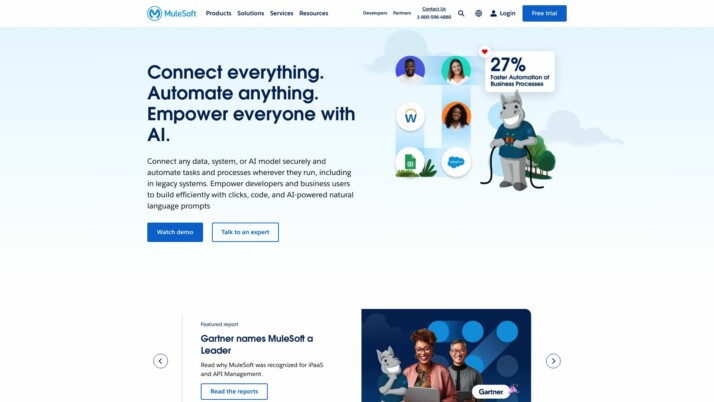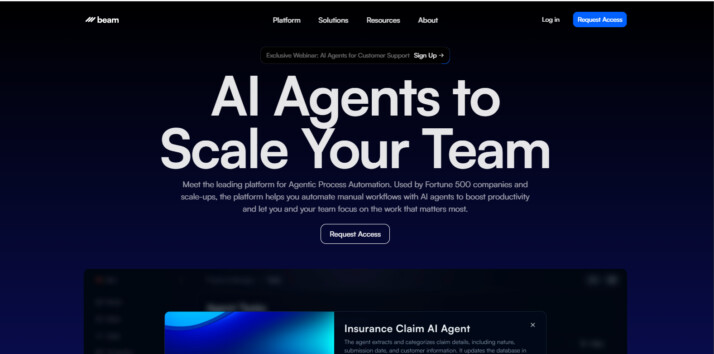Mulesoft vs. Beam AI: Comparing Enterprise AI Solutions
AI-powered solutions are reshaping how businesses operate, integrate systems, and automate processes. This comparison examines three key players in the enterprise AI space: Mulesoft vs. Beam AI, and SmythOS. Mulesoft specializes in API-led connectivity, offering robust tools for designing and managing APIs across diverse environments. Beam AI focuses on Agentic Process Automation, using AI agents to streamline repetitive tasks. SmythOS emerges as a comprehensive platform for creating, deploying, and managing AI agents with unparalleled ease. We’ll explore how each solution addresses integration challenges, automates workflows, and empowers organizations to harness AI’s potential. By the end, you’ll understand the unique strengths of each platform and why SmythOS stands out as the superior choice for businesses seeking to innovate and streamline operations through AI.
Mulesoft Overview
Mulesoft revolutionizes enterprise connectivity and integration with its comprehensive Anypoint Platform. This powerful suite empowers organizations to design, build, and manage APIs, seamlessly connecting applications, data, and devices across on-premises and cloud environments. Mulesoft’s API-led approach enables businesses to create reusable assets, accelerating digital transformation and enhancing agility.


Mulesoft revolutionizes enterprise connectivity and integration with its comprehensive Anypoint Platform … empowers organizations to design, build, and manage APIs, seamlessly connecting applications, data, and devices
Mulesoft excels in providing robust integration solutions for large enterprises, tech-savvy development teams, and IT professionals seeking to streamline complex workflows. The platform’s strength lies in its ability to connect disparate systems, break down data silos, and enable real-time information flow across the organization. This makes it particularly valuable for industries with complex IT ecosystems, such as healthcare, finance, and retail.
Key features of Mulesoft’s offering include Anypoint Studio, a visual development environment for API design and integration, and Anypoint Exchange, a marketplace for discovering and sharing reusable assets. The platform also incorporates AI capabilities through Einstein AI integration, enhancing developer productivity with features like natural language-based project initiation and intelligent data mapping.
While Mulesoft provides powerful tools for integration and API management, its learning curve can be steep for users without a strong technical background. The platform’s enterprise focus also means it may be overkill for smaller organizations or those with simpler integration needs. Additionally, pricing can be a concern for some businesses, as Mulesoft’s enterprise-grade solutions come with corresponding costs.
Mulesoft’s integration capabilities extend beyond traditional APIs, supporting various data formats and protocols. This flexibility allows businesses to connect legacy systems with modern cloud applications, IoT devices, and emerging technologies. The platform’s robust security features, including Anypoint Flex Gateway, ensure that these integrations remain protected and compliant with industry standards.
Beam AI Overview
Beam AI revolutionizes task automation with its Agentic Process Automation (APA) technology. These AI-powered agents tackle repetitive manual tasks across various business functions, from data processing to customer service. Beam’s platform enables organizations to create, deploy, and manage intelligent agents that continuously learn and adapt, improving efficiency and accuracy over time.
Beam AI revolutionizes task automation with its Agentic Process Automation (APA) technology … agents tackle repetitive manual tasks across various business functions, from data processing to customer service.
The core strength of Beam AI lies in its ability to automate complex workflows. Its agents excel in areas such as data extraction, customer inquiry management, compliance tasks, and order optimization. This versatility makes Beam AI particularly valuable for back-office operations, customer service departments, and compliance-heavy industries.


Beam AI’s platform integrates seamlessly with existing systems, allowing for efficient workflow planning and execution. The agents feature advanced conversational interfaces, facilitating natural interactions between humans and AI. This approach not only streamlines processes but also enhances user experience across various touchpoints.
Beam AI’s platform integrates seamlessly with existing systems … The agents feature advanced conversational interfaces, facilitating natural interactions between humans and AI.
While Beam AI offers powerful automation capabilities, users should consider potential limitations. The platform’s effectiveness depends heavily on the quality and quantity of data available for training. Additionally, as with any AI system, there may be challenges in ensuring complete transparency in decision-making processes, which could be a concern in highly regulated industries.
In the competitive landscape of AI agent builders, Beam AI stands out for its focus on sustainability and efficiency. The company’s commitment to minimizing steps in achieving goals aligns with the growing demand for eco-friendly business solutions. However, potential users should evaluate how Beam AI’s specific features and integration capabilities match their unique organizational needs and existing tech infrastructure.
Feature Comparison
Mulesoft and Beam AI offer distinct approaches to enterprise integration and task automation. Mulesoft excels in API-led connectivity and integration, providing robust tools for designing, building, and managing APIs across diverse environments. Its Anypoint Platform enables seamless connections between applications, data sources, and devices, supporting both on-premises and cloud deployments. Mulesoft’s strength lies in its comprehensive integration capabilities, making it ideal for complex enterprise ecosystems.
Beam AI, on the other hand, focuses on Agentic Process Automation (APA), leveraging AI-powered agents to automate repetitive tasks. While Mulesoft primarily addresses system-to-system integration, Beam AI targets specific business processes like data extraction, customer inquiry management, and compliance tasks. Beam’s agents continuously learn and adapt, potentially offering more dynamic and intelligent automation compared to Mulesoft’s more traditional integration approach.
In terms of security, Mulesoft provides enterprise-grade features including Anypoint Flex Gateway and robust API governance tools. Beam AI’s documentation does not explicitly detail its security measures, which may be a concern for organizations handling sensitive data. Mulesoft’s extensive ecosystem of connectors and its API-first approach offer greater flexibility in integrating with various systems, whereas Beam AI’s focus on specific use cases may limit its applicability in certain enterprise contexts.
Feature Comparison Table
| Mulesoft | Beam AI | SmythOS | |
|---|---|---|---|
| CORE FEATURES | |||
| Visual Builder | ✅ | ❌ | ✅ |
| No-Code Options | ✅ | ❌ | ✅ |
| Memory & Context | ❌ | ✅ | ✅ |
| Explainability & Transparency | ❌ | ✅ | ✅ |
| Debug Tools | ✅ | ❌ | ✅ |
| Multimodal | ✅ | ❌ | ✅ |
| Problem-Solving Capabilities | ❌ | ✅ | ✅ |
| Human-AI Interaction | ❌ | ✅ | ✅ |
| Audit Logs for Analytics | ❌ | ✅ | ✅ |
| SECURITY | |||
| Data Encryption | ❌ | ✅ | ✅ |
| COMPONENTS | |||
| Huggingface AIs | ❌ | ✅ | ✅ |
| Zapier APIs | ❌ | ✅ | ✅ |
| All other APIs, RPA | ❌ | ✅ | ✅ |
| Logic | ❌ | ✅ | ✅ |
| Data Lakes | ✅ | ❌ | ✅ |
| DEPLOYMENT OPTIONS (EMBODIMENTS) | |||
| Deploy as Scheduled Agent | ❌ | ✅ | ✅ |
| Scalability | ❌ | ✅ | ✅ |
| DATA LAKE SUPPORT | |||
| Hosted Vector Database | ✅ | ❌ | ✅ |
| Sitemap Crawler | ❌ | ❌ | ✅ |
| YouTube Transcript Crawler | ❌ | ❌ | ✅ |
| URL Crawler | ❌ | ❌ | ✅ |
| PDF Support | ❌ | ✅ | ✅ |
Best Alternative to Mulesoft and Beam AI
SmythOS stands out as the superior alternative to Mulesoft and Beam AI, offering a comprehensive AI automation platform that combines the best of both worlds. Our platform excels in providing a user-friendly, versatile solution for creating and deploying AI agents across various use cases.
Unlike Mulesoft’s complex API-led integration approach or Beam AI’s narrow focus on specific business processes, SmythOS offers a drag-and-drop interface that simplifies AI agent creation. This visual builder empowers users of all skill levels to design sophisticated AI workflows without extensive coding knowledge, democratizing AI development across organizations.
SmythOS offers a drag-and-drop interface that simplifies AI agent creation… empowers users of all skill levels to design sophisticated AI workflows without extensive coding knowledge
SmythOS’s feature set surpasses both competitors in critical areas. While Mulesoft lacks memory and context capabilities, and Beam AI falls short in visual building tools, we provide both, ensuring our AI agents can maintain context over conversations and adapt to user needs. Our platform also offers superior explainability and transparency, debug tools, and multimodal capabilities, addressing limitations found in both Mulesoft and Beam AI.
Perhaps most importantly, SmythOS shines in its unlimited use cases. Unlike Beam AI’s focus on specific business processes or Mulesoft’s emphasis on system integration, our platform supports a wide range of applications, from chatbots and virtual assistants to complex data analysis and decision-making tools. This versatility, combined with our robust integration capabilities, allows businesses to leverage AI across their entire operation, driving innovation and efficiency at every level.
By choosing SmythOS, organizations gain access to a powerful, flexible, and user-friendly AI platform that outperforms both Mulesoft and Beam AI. Our solution empowers businesses to harness the full potential of AI, transforming their operations and driving significant advancements across industries.
Conclusion
Mulesoft and Beam AI offer powerful solutions for enterprise integration and task automation, each with unique strengths. Mulesoft excels in API-led connectivity, providing robust tools for designing and managing APIs across diverse environments. Its comprehensive Anypoint Platform supports complex enterprise ecosystems, making it ideal for large organizations with intricate IT landscapes.
Beam AI, focusing on Agentic Process Automation, leverages AI-powered agents to automate repetitive tasks. Its strength lies in adaptability and continuous learning, potentially offering more dynamic automation for specific business processes like data extraction and customer inquiry management.
However, SmythOS emerges as the superior choice, combining the strengths of both platforms while addressing their limitations. SmythOS offers a comprehensive suite of tools for creating, deploying, and managing AI agents with unparalleled ease and flexibility. Its intuitive drag-and-drop interface democratizes AI development, making advanced automation accessible to users across technical skill levels.
SmythOS stands out with its extensive integration ecosystem, supporting over 300,000 integrations and various AI models. This versatility allows for seamless incorporation into existing workflows and rapid deployment across multiple platforms. The platform’s ’Create Once, Deploy Anywhere’ approach significantly reduces development time and enhances scalability.
For businesses seeking to harness the full potential of AI-driven automation, SmythOS provides the ideal solution. Its robust features, including multi-agent collaboration, advanced security measures, and versatile deployment options, position it as the go-to platform for organizations looking to innovate and streamline their operations. To experience the transformative power of SmythOS, create a free account and start building your AI-powered future today.
Last updated:
Disclaimer: The information presented in this article is for general informational purposes only and is provided as is. While we strive to keep the content up-to-date and accurate, we make no representations or warranties of any kind, express or implied, about the completeness, accuracy, reliability, suitability, or availability of the information contained in this article.
Any reliance you place on such information is strictly at your own risk. We reserve the right to make additions, deletions, or modifications to the contents of this article at any time without prior notice.
In no event will we be liable for any loss or damage including without limitation, indirect or consequential loss or damage, or any loss or damage whatsoever arising from loss of data, profits, or any other loss not specified herein arising out of, or in connection with, the use of this article.
Despite our best efforts, this article may contain oversights, errors, or omissions. If you notice any inaccuracies or have concerns about the content, please report them through our content feedback form. Your input helps us maintain the quality and reliability of our information.

